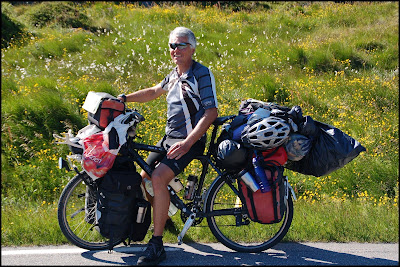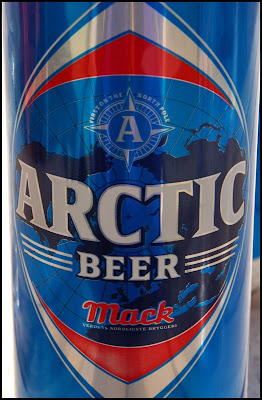Isles of mystique and
Adventure
Even if you leave – your roots will
remain. Lofoten proverb
From the deck of MS Bodø, ploughing through the Norwegian Sea , I watch troll-like mountains form an
uncompromising barrier. They belong to Norway
The typically archipelago landforms, joined by bridges
or tunnels, extend like a giant arm over 100 kilometres from Norway
The seascapes and landforms suggest an isles where
mystique thrives. Myths preceding the Viking Age (eighth to eleventh century)
tell of an agreeable people, the hyperborean,
amongst them the mother of the Greek God Apollo. Other myths tell of beautiful
wicked women adept in the art of sorcery.
Lofoten is also the birth place of the contemporary balladeer
Kari Bremness whose haunting songs of travel have captured the hearts of
audiences in Europe and Japan
The ship slows. People are shouting ``we’re here.’’ I
find Haruko, my cycling partner, and we fall in line with others descending
steel stairways to the vehicle deck. A
gentle bump on the quayside is followed by the frenetic rattle of machinery. We
merge with the scramble of cars and campervans escaping under the gaping
bows.
Our three-hour ferry sailing has brought from Bodø to
Moskenes.
Lofoten is immediately different. Wedged between pointed
mountains and a serene ocean, diminutive pockets of land provide home for a
sparse population proudly calling themselves Lofoteners.
Traditionally cod fishermen and their families, they
live in unpretentious, albeit eye-pleasing, villages of colourful wood
dwellings. Their red-painted fishing shacks (rorbu cabins) crowd the shoreline
so closely they are partially supported on piles embedded in the sea.
A leisurely six-kilometres of pedalling takes us to
the fishing village Å (pronounced Or) at the southern extremity of European
Highway 10. Despite being cocooned within the Arctic Circle – approximately 66 degrees
north – the July day is warm. On a grassy knoll above a rocky shore we pitch
our small tent, stretch out on the grass, and lazily watch fishing boats
bobbing in an ocean of amazingly clear sea.
Lofoten has been scheduled as an idyllic island-hopping
detour on a Nordic bike ride that will take us north to Tromso prior to
crossing Finland Lapland . We already have 2100 kilometres in
our legs – having cycled the alpine Highway 55 to Otta’s tourist hub before
taking an overnight train to Bodo. For Lofoten,
we have planned an almost leisurely 280 kilometre ride, south to north, over
six days.
The route weaves between the inner (sheltered) and
outer (exposed) coasts. Not being in a rush becomes a good plan as we tackle
the first day. Around almost every bend we are compelled to stop. Sheltered
coves of Reine and Hamnøy are especially appealing. Above pointed mountains
wispy wind clouds are reminiscent of those seen over New Zealand Southern Alps.
Hamnoy
Hamnoy
Between wooden fishing shacks are the now empty wooden
racks where the winter cod catch is dried to become stockfish. The drying must
coincide with temperatures being sufficiently low so as to not attract flies
and maggots. A continuous breeze will carry a seaborne salinity.
No other country successfully conserves cod this way. Stockfish
will survive for years as a nutritious natural food. Most is exported to European countries and to
Nigeria
The fishery is a gift of the Gulf
Stream originating in Mexico Atlantic Ocean . Norway Canada
For much of the day we pedal in conditions remindful
of a balmy New Zealand Flakstadøya
Island
Late afternoon we align out tent with the gale.
Arrival of other cyclists, families on motor bikes and the ubiquitous
campervans build a camaraderie along with a little shelter. At a nearby
supermarket we mentally build a meal around an oversized can of meatballs and a
satchel of Lofoten Fiskesuppe (fish soup). We complement with beer. Wine and
anything else with higher alcohol content, is available only from a state-owned
Vinmonopolet shop. We will not find
one in this small seaside settlement.
We crowd into the warming kitchen with strange assortments
of comfort food. Our meatballs are satisfying. The fish soup is a gourmet
delight. Outside, the icy north wind flings clammy misty clouds over the
mountains. Windows steam up.
The tent is mercifully cosy. At midnight , we crawl out to see the sun. We are
not the only ones. Some bravely walk the beach heading into stinging windborne
sand. The bright, reddish, midnight
light is surreal.
Midnight beach
Haruko slips a bottle of cognac from her pocket and we
toast the midnight sun poised comfortably above the horizon. In winter it will
remain below the horizon. It is in winter when most of the cod will be fished. No
wonder locals occasionally appear grumpy.
Next day the sky is clear but the wind still icy. We
tog up with thermals and wind-proofing. Much of the day we cycle on the lee
side of the mountains and we walk through a two kilometre Nappstraum undersea
tunnel to our next island, Vestvagøya. Tiring of the wind we find another
welcoming campsite. I am surprised by the ill feelings expressed towards German
people owing to the German occupation during WW2. Norwegians bravely sabotaged
many of their occupier’s initiatives. Yet many visitors hail from Germany
Finding our way through the labyrinth of these isles is
remarkably easy thanks to Norwegian cyclist, Knut Bjoraa, who has produced a
series of card maps Castor Forlag
with all-you-need-to-know about accommodation, cafes and food supplies along
with visual and historic highlights.
And Lofoten roads rarely rise too far above the sea.
Road builders attempting to ascend these sheer mountains rising from the ocean would
soon be defeated. Pedalling here is not so strenuous. And once the wind eases,
the experience becomes decidedly pleasurable.
On the island Gimsøya we detour to Hov on the north
facing coast. The camp manager recommends the nearby Café hull 19 also known as
the ``whale café’’ with a competent chef.
Haruko, having no scruples about eating whale, says I should try. Being from
a country fiercely opposed to hunting whales I am reluctant. But I am also
curious. And, on Sunday, it is the only place we can buy a beer. Shamefully I relent.
Café hull is part of a nine-hole golf course, one of
the world’s small number where players can tee off at midnight . I order the hvalbiff (whale beef) at
Kr 179 (about $NZ 45). I have seen whale
meat displayed in supermarkets and it has not looked appetising.
The dish is pleasantly good. The taste is like beef
leaning towards liver. It is accompanied by canned Arctic Beer, and wine poured
from a cardboard box. Later when I ask if I could photograph the menu board,
Frode Hov, who founded the golf course and café, asks if I am from a travel
guide. I am the first to photograph such details.
We chat about whale being part of the Norwegian diet
when food was scarce after World War 2. These days it is a delicacy. Frode says
a veterinarian is on board boats to ensure minke whales are killed humanely,
regulations are adhered to and quotas not exceeded.
Haruko says it is unfair Japanese are caught up in the
whale controversy when Norway Norway
(Before pedalling away from our final Norwegian fjord a
few days later Haruko and I were to see our own whale cruising, blowing and
diving close to the shore – truly a magical experience.)
From Hov, our cycling route dives back to the inner
coast leading us precariously over high bridges (built to allow ships to pass
beneath). The bridges join a series of tiny islands jutting into the ocean and
terminating at Henningsvaer, one of Norway’s best known fishing villages. We
explore narrow twisting lanes to discover a cosy bar with views of sail and
fishing craft moored in the inlet.
On another day we ride through Kabelvåg with its
famous wood cathedral, and Svolvaer a busy ferry terminal and 1956 birthplace of
Kari Bremness. In her biographical notes she talks about her inspiration from
summers filled with light and the mythical dark season.
These days the E 10 highway joins Lofoten and the
Vesterålen isles via a tunnel. We leave Lofoten as we arrived, taking a car ferry
from Fiskebøl, across Hadselfjorden, to Melbu. The crossing is made in 25
minutes.
Mist swirls around the bush and mountains, reminiscent
of New Zealand’s Milford Sound. Drizzle sets in. Glancing at the gaping open ferry
bows I think about my well digested whale meat steaks. Am I a latter day Jonah about
to be swallowed up? At Melbu I am grateful to be escaping.
At the information centre we are approached by a
cheerful guy with an impressive moustache. Erling Bjørstad is a teaching chef.
He leads us upstairs to sample his students’ bacalao. It is a casserole made
from stockfish potatoes and onion with tomato paste and garlic. He writes the
recipe on my notepad before ladling generously from a large pot.
Erling Bjorstad
`It’s good food for the heart,’ he says, meaning, I guess, the soul. It is excellent accompanied by cold water. It is all free. As the rain sets in outside the bacalao indeed warms our souls. And, this time, I eat a sea creature without feeling a cad.
`It’s good food for the heart,’ he says, meaning, I guess, the soul. It is excellent accompanied by cold water. It is all free. As the rain sets in outside the bacalao indeed warms our souls. And, this time, I eat a sea creature without feeling a cad.
Bike-norway.com










No comments:
Post a Comment